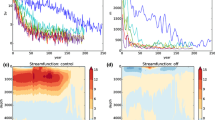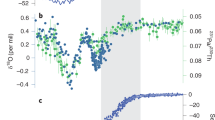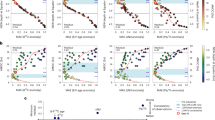Abstract
The sensitivity of the Atlantic circulation and watermasses to biases in the convergence of moisture into the basin is examined in this study using two different general circulation models. For a persistent positive moisture flux into the tropical Atlantic, the average salinity and temperature in the basin is reduced, mainly below mid-depths and in high latitudes. A transient reduction in the Atlantic overturning strength occurs in this case, with a recovery timescale of 1–2 centuries. In contrast, a similar amount of freshwater directed into the Subpolar North Atlantic results in a persistent reduction in overturning and an increase in basin heat and salt content. In the unperturbed pre-industrial simulations, the Atlantic is unambiguously warmer and saltier than historical observations below mid-depths and in the Nordic Seas. The models’ tropical freshwater flux sensitivities project strongly onto the spatial pattern of this bias, suggesting a common atmospheric deficiency. The integrated Atlantic plus Arctic surface freshwater flux in these models is between −0.5 and −0.6 Sv, compared with an observational estimate of −0.28 Sv. Our results suggest that shortcomings in the models’ ability to reproduce realistic bulk watermass properties are due to an overestimation of the inter-basin moisture export from the tropical Atlantic.







Similar content being viewed by others
References
Adler R, Huffman G, Chang A, Ferraro R, Xie S, Janowiak J, Rudolf B, Schneider U, Curtis S, Bolvin D, Gruber A, Susskind J, Arkin P, Nelkin E (2003) The version-2 global precipitation climatology project (GPCP) monthly precipitation analysis (1979–present). J Hydrometeorol 4:1147–1167
Anderson WG, Gnanadesikan A, Wittenberg AT (2009) Regional impacts of ocean color on tropical pacific variability. Ocean Sci 5(3):313–327
Antonov JI, Seidov D, Boyer TP, Locarnini RA, Mishonov AV, Garcia HE, Baranova O, K Zweng MM, Johnson DR (2010) World Ocean Atlas 2009, vol 2: salinity. In: Levitus S (ed) NOAA Atlas NESDIS 68. US Government Printing Office, Washington, DC p 184
Bamber J, van den Broeke M, Etterna J, Lenaerts J, Rignot E (2012) Recent large increases in freshwater fluxes from greenland into the North Atlantic. Geophys Res Lett 39(19):L19501
Barber D, Dyke A, Hillaire-Marcel C, Jennings A, Andrews J (1999) Forcing of the cold event of 8,200 years ago by catastrophic drainage of laurentide lakes. Nature 400:344–348
Broecker W (1994) Massive iceberg discharges as triggers for global climate change. Nature 372:421–424
Cunningham S, Kanzow T, Rayner D, Baringer M, Johns W, Marotzke J, Longworth H, Grant E, Hirschi J, Beal L, Meinen C, Bryden H (2007) Temporal variability of the Atlantic meridional overturning circulation at 26.5°N. Science 317:935–938
Dai A (2006) Precipitation characteristics in eighteen coupled climate models. J Clim 19:4605–4630
Dai A, Trenberth K (2002) Estimates of freshwater discharge from continents: latitudinal and seasonal variations. J Hydrometeorol 3:660–687
Delworth TL et al (2006) GFDL’s CM2 global coupled climate models. Part I: formulation and simulation characteristics. J Clim 19:643–674
Dunne J et al (2012) GFDLs ESM2 global coupled climate-carbon earth system models. Part I: physical formaulation and baseline simulation characteristics. J Clim 25:6646–6666
Ganachaud A, Wunsch C (2003) Large-scale ocean heat and freshwater transports during the world ocean circulation experiment. J Clim 16:696–705
Griffies SM et al (2005) Formulation of an ocean model for global climate simulations. Ocean Sci 1:45–79
Hallberg R, Adcroft A (2009) Reconciling estimates of the free surface height in lagrangian vertical coordinate ocean models with mode-split time stepping. Ocean Model 29(1):15–26
Huisman S, den Toom M, Dijkstra HA (2010) An indicator of the multiple equilibria regime of the Atlantic meridional overturning circulation. J Phys Oceanogr 40:551–567
Locarnini RA, Mishonov AV, Antonov JI, Boyer TP, Garcia HE, Baranova OK, Zweng MM, Johnson DR (2010) World Ocean Atlas 2009, vol 1: temperature. In: Levitus S (ed) NOAA Atlas NESDIS 68. US Government Printing Office, Washington, DC, p 184
Lumpkin R, Speer K (2007) Global ocean meridional overturning. J Phys Oceanogr 37:2550–2562
Manabe S, Stouffer RJ (1997) Coupled ocean-atmosphere model response to freshwater input: comparison to younger dryas event. Paleoceanography 12(2):321–336
Nicolas JP, Bromwich DH (2011) Precipitation changes in high Southern latitudes from global reanalyses: a cautionary tale. Surv Geophys 32(4–5):475–494
Reid JL (1997) On the total geostrophic circulation of the North Atlantic ocean: flow patterns, tracers and transports. Progr Oceanogr 39:263–352
Rienecker M et al (2009) Synthesis and assimilation systems: essential adjuncts to the global observing system, vol 1. In: Ocean obs ’09: sustained ocean observations and information for society, p 31
Schmittner A, Clement AC (2002) Sensitivity of the thermohaline circulaton to tropical and high latitude freshwater forcing during the last glacial–interglacial cycle. Paleoceanography 21(2):1–13
Schmittner A, Appenzeller C, Stocker T (2000) Enhanced Atlantic freshwater export during El Niño. Geophys Res Lett 27(8):1163–1166
Sijp WP (2012) Characterising meridional overturning bistability using a minimal set of state variables. Clim Dyn 39:2127–2142
Spence JP, Weaver AJ (2008) The impact of tropical Atlantic freshwater fluxes ion the North Atlantic meridional overturning circulation. J Clim 19:4592–4604
Talley DL (2008) Freshwater transport estimates and the global overturning circulation: shallow, deep and throughflow components. Progr Oceanogr 78(4):257–303
Weijer W, de Ruijter WPM, Dijkstra HA, van Leeuwen PJ (1999) Impact of interbasin exchange on the Atlantic overturning circulation. J Phys Oceanogr 29(9):2266–2284
Weijer W, Maltrud ME, Hecht MW, Dijkstra HA, Kliphuis MA (2012) Response of the Atlantic ocean circulation to greenland ice sheet melting in a strongly-eddying ocean model. Geophys Res Lett 39(9):6
Wijffels SE, Schmitt R, Bryden H, Stigebrandt A (1992) Transport of freshwater by the oceans. J Phys Oceanogr 22:155–162
Woodgate R, Aagaard K, Weingartner T (2006) Interannual changes in the bering strait fluses of volume, heat and freshwater between 1991 and 2004. Geophys Res Lett 33(15):L15609
Acknowledgments
M. Harrison is grateful to Rym Msadek and Rong Zhang for their feedback on an earlier version of this manuscript. Also, thanks to Robbie Toggweiler for several useful discussions. Two anonymous reviewers provided exceptional reviews and we are thankful for their efforts. All of the analysis and figures presented here were programmed exclusively in Python using freely-available packages including Numpy, Matplotlib, and NetCDF-4.
Author information
Authors and Affiliations
Corresponding author
Rights and permissions
About this article
Cite this article
Harrison, M., Adcroft, A. & Hallberg, R. Atlantic watermass and circulation response to persistent freshwater forcing in two coupled general circulation models. Clim Dyn 42, 59–68 (2014). https://doi.org/10.1007/s00382-013-1798-5
Received:
Accepted:
Published:
Issue Date:
DOI: https://doi.org/10.1007/s00382-013-1798-5




